What is a Nurture/Workflow Campaign?
Nurture/Workflow Campaigns can take a variety of actions including sending emails, modifying field values, and adjusting lead scores (and many more). Nurture Campaigns can “hand off” to other campaigns by leveraging the modify list membership action.
They can also send emails based on the attributes and/or behavior of the participating contacts! If you wish to do anything besides send an email, you must use a Nurture/Workflow Campaign!
Good use cases for a Nurture/Workflow Campaign include (but are not limited to):
- Webinars Emails where you’d like to send reminders to those that have not registered
- Workflows where you only want to send follow ups to those that did not click within an email
- Workflows where you’d like to send different emails to contacts based on their location or other static field value.
- Workflows that don’t send an email! You can use Nurture/Workflow Campaigns to do something like… Modify List Membership and nothing else!
Settings Tab
When you first create any type of campaign in Net-Results, you’ll be taken directly to the Settings tab. The settings tab consists of some high level settings about how you’d like the campaign to work. Options such as One Time or Perpetual, choosing the launch date, and UTM tagging are all available here. Below is a list of the items that are on the settings tab.
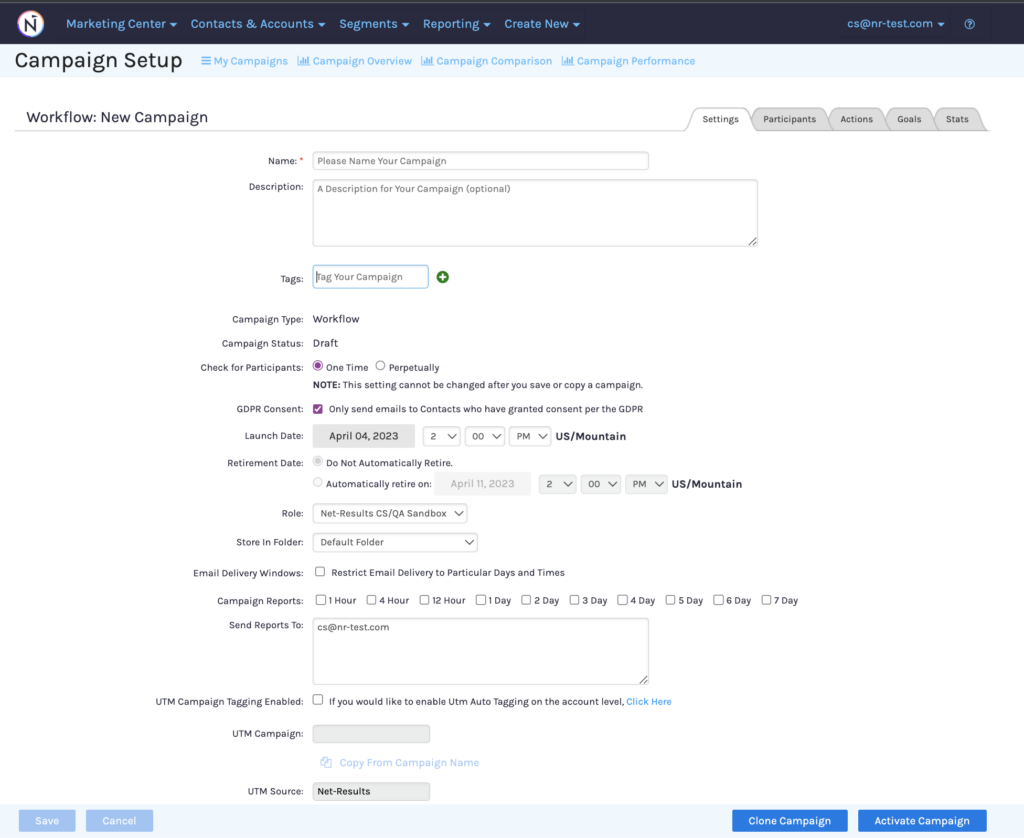
Setting Definitions
- Name – Name the campaign. We suggest being specific so that you can easily tell what this campaign was in the future!
- Description – If you’d like to write a description of this campaign, you can do so here.
- Tags – Tagging campaigns with a keyword that identifies the campaign can be helpful for future reporting! If you send monthly newsletters, tagging the campaigns with “monthly newsletter” will allow you to pull a report for all campaigns tagged with “monthly newsletter” in the future! Read more on Tags & how to use them.
- Campaign Type – This is an uneditable option, this option will just let you know whether you are working in a Drip, Nurture or A/B Split test campaign.
- GDPR Consent – When GDPR rolled out back in May of 2018, we implemented a few features that will help our clients who work with EU citizens stay compliant. If you check this box, it means that this campaign will only send to contacts who have the GDPR Consent Field on their contact detail set to True.
- Contacts do not have this field set automatically. It is left blank until a workflow is set up to set this field. Do not check this box unless you are actively using the GDPR consent field.
- Launch Date – Choose your launch date! You can set a launch time by 5 minute increments here!
- Retirement Date – Only used when working with Perpetual Campaigns here is where you can choose whether you would like the campaign to never retire, or if you’d like it to run perpetually for a month and then retire. The options you can choose from are listed as:
- Do Not Automatically Retire
- Automatically Retire On (you set the date)
- Role – You’ll have two different roles, one that is a generic company level role & one that is specific to your user. If you change the role to be specific to your user, that means that no one else on your team that logs in to Net-Results will see the campaign you are creating. It will only be visible to you.
- In most cases, Role is safe to ignore. You will see it a few places in Net-Results. If you do not need to remove visibility to the content that is created in Net-Results, leave the Role alone. 🙂
- Store In Folder – You can organize campaigns in folders so that you can easily find them on the My Campaigns page. You will need to create the folder ahead of time on the My Campaigns page, but you can select it on the Campaign Settings tab!
- Email Delivery Windows – Gives you the ability to send emails only on specific days and even only during certain times of the day. Something to note with delivery windows is when leveraged, it will delay the emails sends by one hour. This is a check put in place to ensure we are not delivering emails outside of your windows.
- Campaign Reports – Instead of creating a scheduled report, you can go ahead and choose to get a campaign report right from the Campaign Settings tab! You can choose who to send the report to and you can send to multiple users by separating them with a comma.
- UTM Campaign Tagging Enabled – You can enable UTM tagging on a campaign by campaign basis by checking this box, OR you can enable automatic UTM tagging on the account level.
- Sync This Campaign to CRM – If you are leveraging one of our native integrations with Salesforce, Dynamics or Sugar – you will see little checkbox at the bottom of the settings tab that allows you to choose if you’d like to have a campaign created in your CRM.
- Something to note here is that this will only create a shell of a campaign in your CRM. Without leveraging the Sync to CRM action on the Actions tab (read further to learn more), this setting is a bit pointless as no members will be in the campaign in your CRM!
- Disable Tracking of Email Opens and Clicks in this Campaign – Allows you send a campaign with non-trackable emails. This is on the campaign level – if this option is selected all emails in the campaign will be non-trackable.
Participants Tab
You guessed it! The participants tab is where you will decide which contacts will be able to qualify for the campaign. This could be something as simple as a list of contacts, or as complex as a built out segment identifying contacts based on their PII for this campaign. When working on the participants tab, you will have two views: Simple and Advanced.
Simple View
This will be the default view when you first navigate to the participants tab. When working on the Simple View, you can only include/exclude lists, subscriptions or specific individuals. It’ll look like the below:
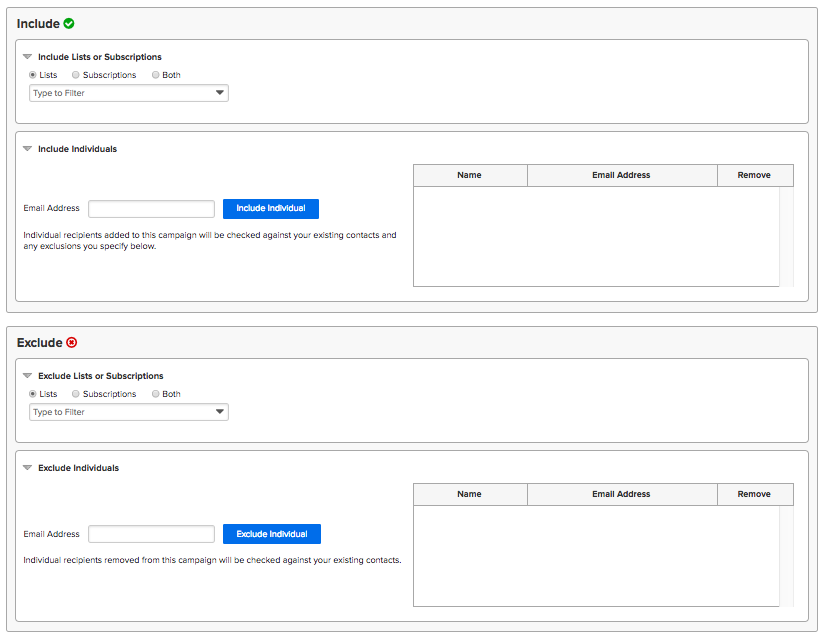
Advanced View
You can toggle to the advanced view by hitting the radio button in the upper left hand corner by “Advanced”. This will take you to a screen that looks almost identical to our Segmentation Engine.
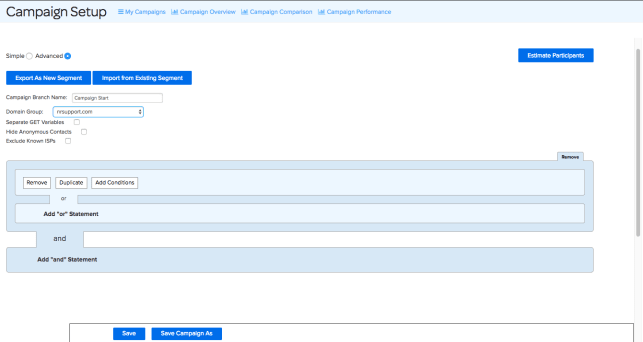
If you’ve already built out a segment using our Segmentation Engine, you can import it here by hitting “Import from Existing Segment”. If you’ve spent a lot of time building out criteria in a campaign, you can export the segment to the My Segments page by hitting the “Export As A New Segment”.
The Advanced View is where you can build out criteria such as:
- Lead Stage Does Match “Prospect” AND State Does Match “Colorado”
The above means that only contacts who have a lead stage of “prospect” and a state that matches Colorado will qualify!
There are a lot of different conditions that you can segment off of, to learn more about those check out our Segments section!
Actions Tab
Nurture/Workflow Campaigns feature drag and drop actions that you can add to any Campaign Action Group! The layout looks quite different than a Drip Campaign. When you initially go to the Actions tab, you’ll be greeted with an area that looks like the below:
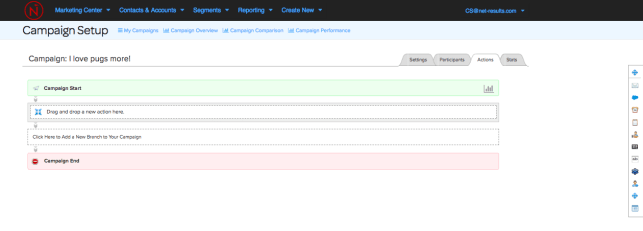
Available Nurture/Workflow Actions
The draggable actions are located to the far right on the sidebar! If you hover over that sidebar, you’ll see the available options!
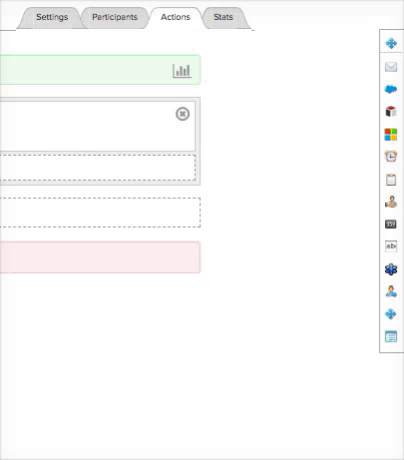
- Send Email – This allows you to send an email.
- *Sync With CRM – If you have one of our native integrations with Salesforce, Dynamics or Sugar – you can sync contacts back to your CRM via this action! When used in conjunction with the “Sync Campaign to CRM” setting on the Settings tab, this action will associate all contacts of this campaign as members of the campaign in your CRM!
- Send Notification – Send an email notification to any email addresses of your choosing. You can send notifications when a campaign branch executes, when an email is opened or when an email is clicked!
- Modify List Membership – Add/Remove the Contact to/from one or more Net-Results lists.
- Assign Lead Owner – Assign the Contact to a Lead Owner.
- Adjust Lead Score – Increase (or decrease) a Contacts Lead Score. Being that Net-Results Lead Scores consist of Contact, Activity, and Engagement Scores, you may adjust any of these in any of your existing Lead Score Overlays.
- Set Field Value – Set a field value. This is great for if you need to make an update to something like “State” where you’d like to change CO to Colorado for all contacts who have a State of CO.
- *Register GoToWebinar – If you have the GoToWebinar Integration setup, automatically register the Contact in any of your upcoming Webinars.
- Send Webhook – A webhook will send a copy of the data submitted via your form via an http POST to any URL of your choosing. This is great for technical folks as it allows you to configure Net-Results to push data straight into your custom application, database, or 3rd party application.
- Modify Subscriptions – Add/Remove the Contact to/from one or more Net-Results Subscriptions.
Add an Action
Adding an action is simple! Simply drag and drop the action of your choosing into place in the Campaign Action Group. You can also add more than one action to any Campaign Action Group.

Creating a Campaign Branch
Unlike in Drip Campaigns, Nurture/Workflow Campaigns can execute follow up actions based on conditional settings that you choose in a Campaign Branch! To add a Campaign Branch, all you need to do is click the box underneath the Campaign Action Group that says “Click Here to Add a New Branch to Your Campaign”. When you click that, you’ll see a screen that looks exactly like our Segmentation Engine!

You can create branches to send only to a specific lead owners contacts, or even contacts who did not open an the previous email within 3 days of receiving it! When you add a campaign branch, the Campaign Action Group below it will have a “Wait” action automatically applied to it. It will always be set at 0, unless you choose to change it. Depending on the types of conditions in the branch above, the wait time can mean different things.
There is no limit on the amount of branches you create, but be careful – sometimes more branches can cause a campaign to get too complex! Reach out to support if you would like some assistance in strategizing the best way to set up a campaign!
Stats Tab
Here is where you can see all the fun stuff after your campaign has been launched! When you first navigate to the Stats Tab you’ll be greeted with a screen that has three separate parts:
- Top Navigation Bar
- High Level Campaign Information
- Nitty Gritty Campaign Stats
Top Navigation Bar

Starting from the far left, we’ll go over what all of these pieces do & how they can interplay together.
- The furthest left dropdown is where you can switch campaigns and take a look at stats for another campaign!
- Next, the date range. It’s important to always pay attention to the date range! If your stats ever look a little funky to you, check out the date range and make sure it is set to encompass the days when any activity could have occurred!
- The drop down on the far right is where you can apply a specific segment. Did you send an email to a list of contacts that are from all over the country? But now you are interested in seeing specifically how contacts in Colorado interacted with your campaign. If you build a segment that has “State does match Colorado” as the condition, you can apply that segment here and see your stats reflect that segment!
- Just below this drop down is a little button that says “Download” this button allows you to download a PDF of this page! Easily email it to your team!
High Level Campaign Information

Below the Top Navigation Bar is where you can find some quick high level information about your campaign.
- Type – This will tell you the exact type of campaign that you are looking at stats for
- Check For Participants – Are you checking for participants just one time, when the campaign launches? Or are you checking Perpetually? Here is where we will tell you!
- Description – If you choose to write a description on the Settings tab, it’ll show up here!
- Launch Date – The exact launch day and time!
- Status – This is where we will tell you if the campaign is Retired, Active, Under Construction or Paused.
Nitty Gritty Campaign Stats
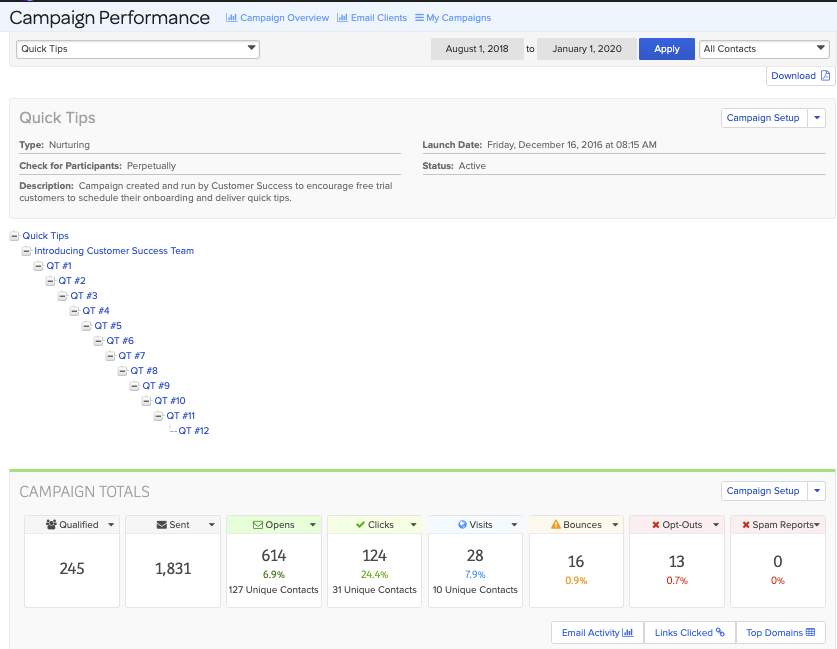
Lastly, you’ll see the Campaign Totals section. In this section there are 7 different categories:
- Qualified – The number of contacts that qualified for the campaign. An important note is that this will encompass any contact that qualified, whether they are mailable or not.
- Sent – The number of emails that were actually sent out.
- Opens – The number of unique opens that have occurred.
- Clicks – The number of clicks that have occurred. In this box, we let you know how many actual unique contacts clicked within the email.
- Visits – The number of visits that occurred from this email. These will be contacts that clicked through to your site and spent time browsing.
- Bounces – The number of emails that bounced when the system attempted to send. In Net-Results, we will attempt to send an email 3 times. If we are unsuccessful three times it is marked as a hard bounce which would be recorded here.
- Opt Outs – The number of contacts that unsubscribed from communications in this campaign.
- Spam Reports – The contacts that marked your email as “spam” in their email client.
Something to note about the Campaign Stats Page for a Nurture campaign, is that you will see all the branches nicely laid out for you right above the Nitty Gritty Campaign Stats section.
If you click on one of those branches, you will see the statistics for that specific branch with the campaign totals right below it still!

Check out this video to learn more!

